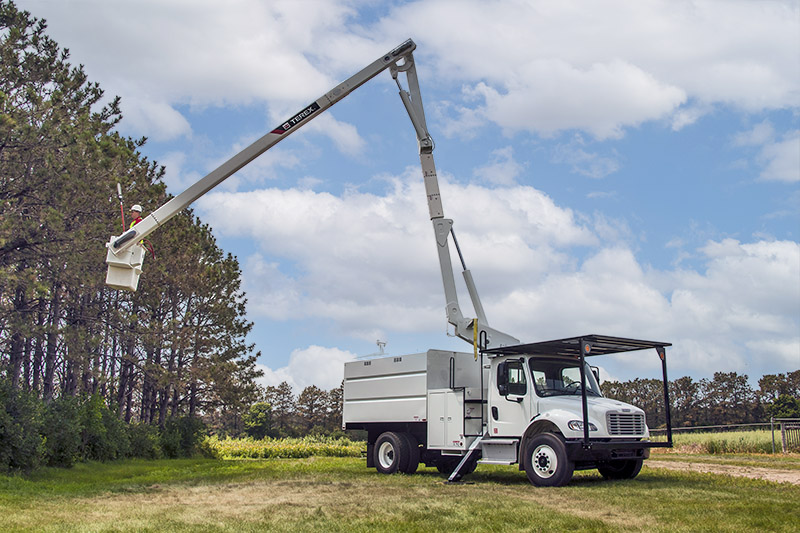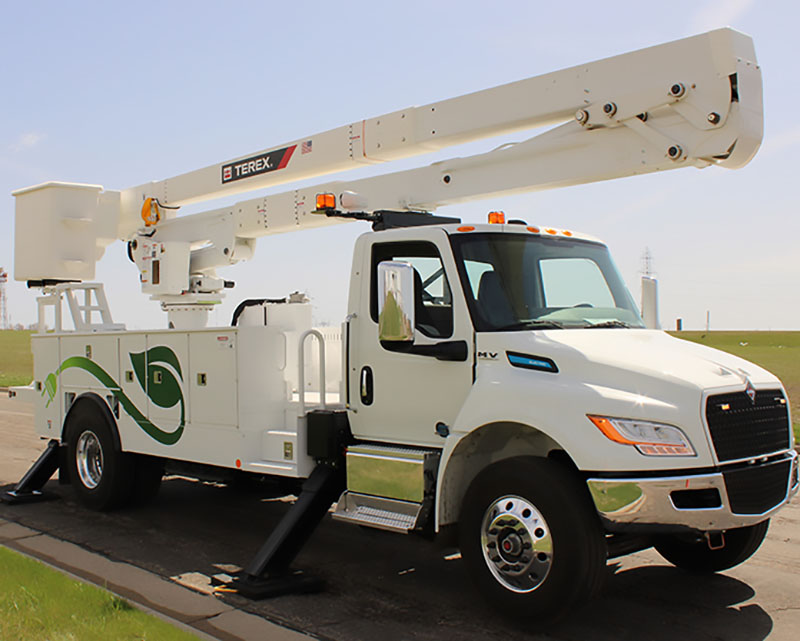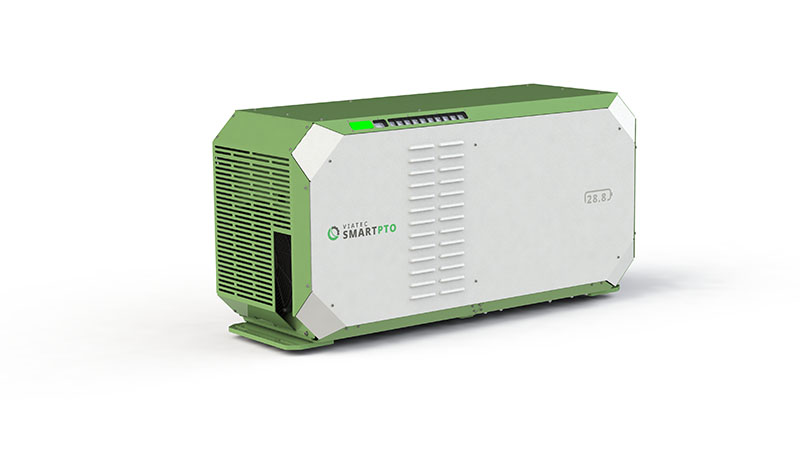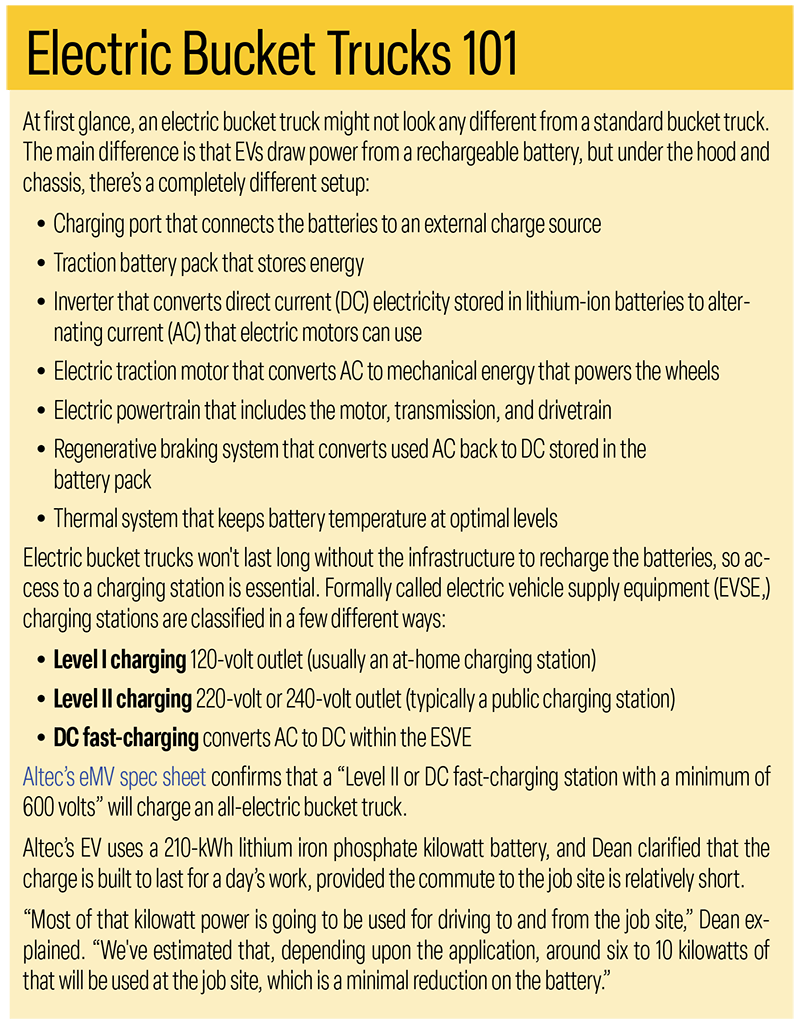Buyers Guide: Hybrid Bucket Trucks
Hybrid models are key to addressing ‘range anxiety’ while eliminating wasteful engine idle
While other industries are embracing EVs, irregular routes and rural areas may limit all-electric bucket truck applications in tree care
Este es nuestro intento de convertir las historias en audio español usando Inteligencia Artificial. Aún así le recomendamos que reconfirme ciertas palabras clave y temas. ArborTIMES no garantiza ni se responsabiliza de la conversión del inglés al español de los relatos.

It’s 2024, and electric vehicles (EVs) are all the rage. With pretty much every major vehicle manufacturer releasing an electric or hybrid option for personal use, this technology is just starting to make its way into the tree care industry.
Major manufacturers like Altec Industries, SEA Electric, and Terex have all released fully electric bucket trucks in recent years. And while these have been embraced by the utility industry and others, several challenges are preventing tree care from doing the same.
While electric technology continues to improve, hybrid options are providing an intriguing stepping stone to help tree care companies looking to go green. Which begs the question: Is it time to add a hybrid bucket truck to your fleet?
Progress in EV technology
Bucket trucks were first invented in the early 1900s. Originally called “cherry pickers,” they were primarily used to safely and efficiently harvest cherries. The power industry quickly saw the benefit of the aerial lift and began using it in their applications.

By the mid-1900s, engineers were building hydraulic systems into bucket trucks, and more industries began to use the technology. Today, the technology exists to run battery-powered bucket trucks that rival similar trucks with internal combustion engines.
Altec collaborated with Smith Electric Vehicles U.S. Corporation on the “first all-electric utility vehicle”
about 15 years ago. The vehicle featured an Altec AT37-G aerial boom and was unveiled at the Electric Utility Fleet Managers Conference (EUFMC.)
SEA Electric, an Australian company, released an all-electric bucket truck in 2019, and Terex Utilities debuted its all-electric bucket truck in June 2022 at the NTEA Work Truck Week conference.
Electric-powered takeoff technology (ePTO) has been on the scene for longer. ePTO technology harnesses electricity from a battery or electric motor to power auxiliary functions that might normally come from a combustion engine. These can include hydraulic systems, power steering, and heating and air conditioning.
Combined with a combustion vehicle, ePTO can reduce or even eliminate the need to keep the engine running to power these functions, resulting in reduced emissions and cost savings.
According to ePTO manufacturer Viatec, the technology has existed for decades but didn’t stick until the turn of the century. Viatec’s SmartPTO represents the third generation of ePTO technology, developed to improve upon previous issues with bulk and instability.
e-Bucket trucks in tree care
While tree care companies use bucket trucks in their daily operations, manufacturers tend to market all-electric products to utility companies instead.
“We are studying electric vehicles as it relates to arborist work practices and taking a thoughtful approach to the tree industry,” said Joe Caywood, director of marketing and product management at Terex. “The one major consideration today for arborists is that their days and routes do not have access for charging overnight.”

Charging is surely one of the major barriers to the widespread use of electric bucket trucks.
“We’ve found that the electric utility customers who are experiencing the greatest success with our electric bucket trucks in the field today have a clear understanding of their routes, duty cycles, and have developed a plan to access charging to get the full benefit of running EV bucket trucks,” Caywood explained.
There are many reasons a tree care company might consider electrifying its fleet — or at least switch to hybrid solutions powered by ePTO.

Sustainability goals
Greenhouse gas emissions produced from burning fossil fuels are having a detrimental impact on the planet. Continuing to build and run gas-powered utility vehicles is not sustainable, and some tree care companies are making an extra effort to be environmentally conscious.
Electric bucket trucks and ePTO generate fewer carbon emissions than gasoline and diesel-powered engines. Collaborative research by Argonne National Laboratory and Viatec found that using a SmartPTO saves an average of 1,890 gallons of fuel each year.
In the U.S., most electricity is generated from natural gas, petroleum, and coal, with a smaller percentage coming from renewable sources and nuclear power. As the percentage of nonrenewable energy production increases, EVs will remain the more sustainable option.

Cost-savings
While “going green” may be a top priority for choosing electric motors over combustion engines, cost savings is another major benefit.
Combustion engine vehicles require fuel, which has only become more expensive in recent years. True EVs have no fuel costs, and hybrid bucket trucks use less fuel than standard trucks.
Also, vehicles with electric motors aren’t as expensive to maintain, though EVs still require other types of maintenance, including brakes, suspension, and tires. Viatec estimates that using a SmartPTO saves between $9,000 and $16,000 in engine maintenance and fuel savings each year.

Enticing tax incentives are also making it a good time to shop for electric. Companies or individuals who purchased plug-in electric vehicles in 2023 or after may qualify for a tax break of up to $7,500.
Federal, state, and local regulations
There’s a reason more all-electric work vehicles are popping up. California’s Advanced Clean Truck Act (ACT,) for example, stipulates that original equipment manufacturers of medium- and heavy-duty vehicles must increase sales of zero-emissions vehicles (ZEVs) and near-zero emissions vehicles beginning this year until 2035. At that time, all new models will need to be ZEVs.
The Rocky Mountain Institute (RMI) reports that six other states have adopted the ACT: Maryland, Massachusetts, New Jersey, New York, Oregon, and Washington. RMI also explains that California’s Advanced Clean Fleet Act (ACF) is a supplement to the ACT, to encourage wider adoption of zero-emission and hybrid vehicles.
Customer and investor preferences
As environmental awareness becomes more prevalent in politics and our daily lives, people are demanding to see action that matches words. Potential customers and investors may favor tree care companies that set sustainability goals and work towards them.

Quieter job site
Besides long-term and environmental benefits, electric bucket trucks also bring immediate value to the table. EVs are quieter than vehicles with combustion engines and contribute to less noise pollution.
“The ability to operate the boom without the diesel engine running has proven valuable in urban areas where noise ordinances are in place and where noise pollution is an annoyance to residents,” Caywood said.
Safer equipment
A quieter work site is also a safer work site, and it’s one of the many perks of using electric and hybrid equipment. Loud noises can make communication difficult between workers on the ground and those in the lift, and a battery-powered aerial lift doesn’t interfere with communications like a traditional PTO does.
“The SmartPTO creates a work zone where operators can communicate better and with less toxic exhaust from the chassis,” Caywood added.
Barriers to e-bucket trucks
In a perfect world, everyone interested in electric bucket trucks would have access to them. In reality, it’s not that simple. Here are some of the biggest challenges to going fully electric.
Larger upfront investment
The biggest problem with electric bucket trucks? The price point, according to Altec’s Green Fleet manager Frank Dean.
“Pricing is a big challenge, and it needs to be competitive compared to diesel,” Dean said of the cost of investing in electric equipment.
Not only are electric bucket trucks more expensive, but tree care companies must factor in the cost of building charging stations and other essential infrastructure to power them.
Limited range
Dean says the biggest hesitation he sees from potential customers is “range anxiety.” Today’s battery technology is as good as it’s ever been – and only getting better – but range continues to be a concern for many tree care companies, especially those that operate in rural areas.
“Range has its limitations right now, and the run requirements that tree care requires make the limited range of EVs a challenge,” he says.
Extreme temperatures

If you’ve tried to start your car on a really cold day and the engine didn’t turn over, you already know extreme temperatures are tough on batteries.
This is true with the lithium-ion batteries used to build all-electric bucket trucks. To counter this, EV manufacturers build auxiliary heating and cooling systems into the system itself to help maximize battery life.
Rod Bergstrom, a sales manager with bucket truck manufacturer Dur-a-Lift, shared that the company’s Hybrid Aerial is built to perform, even in harsh weather conditions.
“The aerial lift is a self-contained unit separate from the chassis powered by a battery that allows up to four hours of continuous run time,” Bergstrom said. “It’s easy to operate and works in cold weather. In Iowa, we understand what cold weather can do to hydraulic equipment.”
Battery wear
Any truck with an internal combustion engine, even the highest-quality electric bucket truck, will deteriorate over time. Altec’s all-electric bucket truck is built to last between seven and 15-plus years, Dean said, which is still an impressive lifecycle for a tree care fleet.
Just like with a battery-powered laptop or cellphone, avoid leaving an EV on the charger past the point of full charge and use fast-charging options sparingly, as both of these habits chip away at battery life. Similarly, it’s best to never let a battery fully die, and it’s recommended to charge an EV to slightly less than 100%.
The value of hybrid
While the technology to run a 100% battery-powered bucket truck is available, manufacturers agree that the best value for tree care companies currently is in hybrid equipment.
Terex’s HyPower SmartPTO, Altec’s JEMS solutions, and Dur-a-Lift’s Hybrid Aerial offer the benefits of battery-powered equipment at the job site, paired with the reliability and range of an internal combustion engine.
“We introduced the HyPower SmartPTO by Viatec concept in 2019 and began delivering it to customers in 2021,” Caywood said. “The SmartPTO features battery options ranging from 7.2 kWh to 28.8 kWh for higher-use applications, such as tree care.”
When asked about the future of electric technology for tree care, Caywood replied that the current key areas of focus include “extending range, reducing cost, and improving charging infrastructure.”
“Until those challenges are addressed, the tree care industry will likely see expanded use of hybrid solutions using SmartPTO as the next step,” Caywood added. “The SmartPTO is a good option for forestry trucks with diesel engines, such as the Hi-Ranger XTPro Series. The addition of SmartPTO allows the full range of your current internal combustion engine while electrifying boom, auxiliary lighting, and outrigger operation.”
Dean agreed that limited range is a major issue with current electric technology and says the best value for tree care companies, particularly those who operate in rural areas, is Altec’s Jobsite Energy Management System (JEMS).
JEMS works with diesel and gasoline engine bucket trucks to maximize driving range and eliminate carbon emissions from jobsite idling. The lithium-ion batteries power the cab comfort controls (A/C, radio, and heat) as well as the bucket.

Looking forward
The tree care industry is no stranger to electric equipment, and electric bucket trucks are the next iteration of an electrification trend across many industries.
“We are seeing a significant shift towards electric equipment across the forestry segment,” Caywood explained, citing the increasing popularity of battery-powered tools such as pole saws and chainsaws, even electric brush chippers.
For tree care companies operating in urban areas with easy access to charging stations, now may be a good time to make the switch to all-electric. For other companies, investing in battery-powered PTO is the next step.
Electric and Hybrid Manufacturers
Terex
Viatec
Altec
Dur-a-Lift
SEA Electric
Versalift


